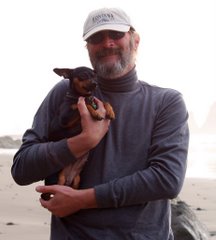 Sign along the driveway into Mount Tabor (Holy Transfiguration) Monastery
Sign along the driveway into Mount Tabor (Holy Transfiguration) MonasteryThis sign bears the mark of my old friend's sense of humor
Taken May 1st, 2007 near Ukiah, California
The voice of God is calling its summons unto men;
As once he spake in
“Whom shall I send to succor my people in their need?
Whom shall I send to loosen the bonds of shame and greed?”
---John Haynes Holmes, 1879-1964
What a week this has been. In the past eight days, I’ve driven almost two thousand miles, slept (or tried to sleep) three nights in motel rooms and three nights at the home of friends, eaten thirteen meals in restaurants, attended a wonderful concert in a beautiful big city concert hall, spent eighteen hours in emotion-packed speaker training sessions, and spoken face to face with a dear friend from my youth. I’m tired.
And the Six Thousand Mile Sunday Drive hasn’t even started yet. This has been good training for the drive, however, and has made me rethink some of the aspects of that next adventure in my life. But for now, I want to talk about service and vocation.
Growing up, I spent most of my at-home learning time with my mother. She gave me a love of reading, a love of foreign languages, a love of music. Most of my religious training came from Mother as well—which may seem unusual for a Preacher’s Kid until we remember that the cobbler’s children often go barefoot. My parents together instilled a love of the outdoors in me, but from Father came my love of being on or near water, my love of photography, and perhaps most important my firm belief in vocation.
Vocation is a word that is misunderstood and misused in today’s culture. It would seem that most people equate the word with job, but at root, a vocation is a calling. Etymologically speaking, vocation comes from the Latin word vocare which means “to call.” I believe that everyone has a vocation, whether it be to ministry, to medicine, to education, or to being a Chevrolet mechanic. A vocation is a sacred position where we find ourselves doing the work we were born to do. There are menial jobs, to be sure, but there are no menial vocations—and I believe that you can be called to serve hamburgers at McDonald’s or greet people at WalMart just as you can be called to enter a monastery on a hilltop outside of Ukiah, California.
My best friend (indeed, my only close friend) in Junior High and High School was a young man named Roy Kaitner. Roy and I spent most of our free time together. With the exception of music classes, we were in different tracks at school, but out of school we would ride our bikes to
We remained close friends after graduation, and even after I left
We heed, O Lord, Your summons, and answer: Here are we!
Send us upon Your errand, let us Your servants be.
Our strength is dust and ashes, our years a passing hour;
But You can use our weakness to magnify Your power.
In the early 1980s,
I will never forget an event that happened in the early 1970s, though. A young woman, a stranger to both of us, fell (or jumped) from one of the tall buildings on the UC campus. Roy and I spent many hours in prayer for her survival.
Roy and I never talked after he moved from
Driving south to
Returning north on Tuesday, I decided to visit
The Chapel at Mount Tabor (Holy Transfiguration) Monastery
Taken May 1st, 2007
The drive up the mountain was longer than the Google map would have indicated, and the road got narrower and narrower the further we drove. Turning into the driveway, we passed a gate indicating that the cloisters were off-limits, but the driveway curved around and up and we continued until we pulled into a parking lot by an ornate gate house complete with onion dome. (Eyefetch image ID: 319799) A young man, looking much like the
Brother Seraphim and I spoke for a few minutes about family, current situations, and old times. We laughed over boyhood exploits, and commiserated over losing our parents. My old friend looked to be truly at peace, and I mentioned that I was glad he had found a home. He replied, pointing toward the ceiling, “a way home.” We did not discuss his vocation, or how he came to respond to that calling. I had heard enough about the monastery both from Lola and from Jan to know that it was a poor place, with food costs being a particular problem. I thought of the fourth verse of the hymn, and was reminded that “plenty” was not a problem facing the monks of
From ease and plenty save us; from pride of place absolve;
Purge us of low desire; lift us to high resolve;
Take us, and make us holy; teach us Your will and way.
Speak, and behold! We answer; command, and we obey!
I did ask if I might take some outdoor pictures without disturbing the order and peace of the place. For some reason, my pictures did not turn out as well as I had hoped, but there are other images on display at Eyefetch. (Eyefetch image ID: 319792, 319814, 319827) There was a palpable feeling of peace on the mountain, and I could easily return there for a meditative retreat. Indeed, I was in quite a contemplative mood as we drove back down the mountain and resumed our drive north on US 101.
Onion Domes and Three-Barred Crosses on the Chapel Roof
Taken May 1st, 2007
Over the past forty years I have often questioned my own vocation, feeling that I was called either to the ministry or to education, but being barred from those two professions by my open homosexuality. On the other hand, I have been very vocal in terms of gay politics and HIV/AIDS education issues, and am coming to the feeling that I am in exactly the right place. Gay people are everywhere, and most of them, through the ignorance of the society around them, and their own fears and shame born from societal opprobrium, are living in their own version of hell. I have long said that if my visibility would keep one young gay man from attempting suicide, I needed to speak out. Perhaps this is my vocation. It is both education and ministry combined. People, both gay and straight, ask me continuously why I have to be so vocal, wouldn’t it be easier to just keep still. But that is the one thing I cannot be. I have fetters to shatter, and the second verse of the hymn is the voice to which I respond.
“I hear My people crying in slum and mine and mill;
No field or mart is silent, no city street is still.
I see My people falling in darkness and despair.
Whom shall I send to shatter the fetters which they bear?”
Blessings on you all.
The Mendocino County Countryside, between Ukiah and Willits
Taken May 1st, 2007







2 comments:
I know this comment is late in coming. I, too, knew Roy Kaitner, though not as long as you did- he lived in the same student co-op I did in Berkeley, Ridge Project. He and John Bally and I hung out a lot together, and climbed many a building and a boulder. I remember when he started asking me "what if the Bible is true?" and being amazed, because he had always seemed to me to be the perfect naturalist. I hope he has a good life.
cheers from sunny Vienna, zilch
Roy is my cousin. I have known him all too little, although we corresponded briefly many years ago. I wish him well and would like to reconnect after all these years if I only knew how.
Post a Comment